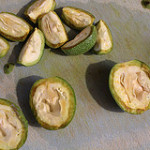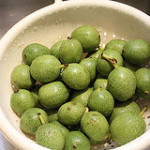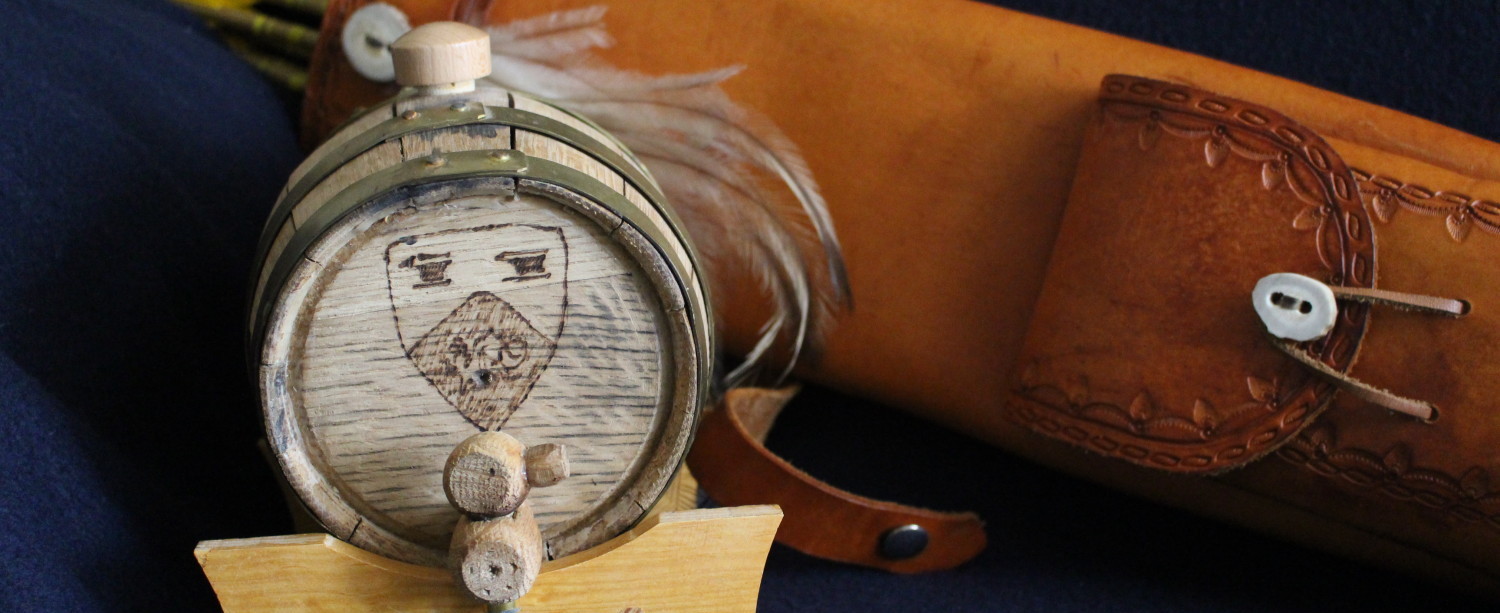Nocino – Part V
The Science of Nocino
And now for the science! While there is not a large body of scientific literature on nocino, what exists is quite interesting.
Walnuts have a long history of use in cooking and medicine. In his first century book, Natural History, Pliny the Elder mentions the use of walnuts and walnut shells for a variety of maladies including tooth pain, tapeworms, hair loss, and bites  from a mad dog! Yikes! There are also references throughout medieval literature for the use of walnuts and walnut tree byproducts (leaves, bark, etc.) for stomach ailments, inflammation, abscesses, etc. Modern science supports, at least in theory, the longstanding use of walnuts and walnut tree components as important medicinal and dietary adjuncts.
from a mad dog! Yikes! There are also references throughout medieval literature for the use of walnuts and walnut tree byproducts (leaves, bark, etc.) for stomach ailments, inflammation, abscesses, etc. Modern science supports, at least in theory, the longstanding use of walnuts and walnut tree components as important medicinal and dietary adjuncts.
Most of the research on nocino focuses on the phenolic and antioxidant properties of the beverage. The phenolic compounds in nocino are largely responsible for the bitter, astringent flavors imparted by the hulls. Phenols are aromatic organic compounds that tend to be mildly acidic. They are partially responsible for the average commercial nocino’s pH being about 4.5 (Alamprese, et al, 2005).
Without getting into too many “gory” details, antioxidants are molecules that  inhibit oxidation of other molecules such as free radicals. Free radicals possess the potential to damage cells in the body. Antioxidants function to neutralize these “toxic” effects of free radicals. Consequently, antioxidants are capable of protecting us from free radicals that may be partially responsible for maladies such as cancer, some joint diseases, and some inflammatory diseases. Many fruits, vegetables, and legumes are excellent sources of antioxidant molecules!
inhibit oxidation of other molecules such as free radicals. Free radicals possess the potential to damage cells in the body. Antioxidants function to neutralize these “toxic” effects of free radicals. Consequently, antioxidants are capable of protecting us from free radicals that may be partially responsible for maladies such as cancer, some joint diseases, and some inflammatory diseases. Many fruits, vegetables, and legumes are excellent sources of antioxidant molecules!
Cristina Alamprese and her colleagues published a couple of studies in Food Chemistry that may be the first formal studies of the components contained in nocino (Alamprese & Pompei, 2005; Alamprese, Pompei, & Scaramuzzi, 2005). In the latter study, Alamprese, Pompei, & Scaramuzzi analyzed several commercial versions of nocino as well as homemade versions constructed by the last author. They found plenty of phenolic compounds in all of the samples, but the variability of the phenolic profiles tended to be quite high.
In what was essentially a follow up to the aforementioned study, Alamprese & Pompei studied a host of variables related to nocino production including when the walnuts are harvested, infusion temperature, and length of infusion time. Alamprese & Pompei collected walnuts on three separate dates: June 13, June 24, and July 4. I already discussed the effect of harvest time on the firmness of the  unripe walnuts. They found that overall phenol content of the resulting nocino varied with the harvest date. Earlier harvesting led to higher overall phenol content. Infusing for longer periods of time (15 vs. 40 vs. 90 days) also led to higher phenol content, but infusion temperature (20 vs 40 degrees C) made no difference. Overall, harvesting the unripe walnuts by the time of the Feast of St John (June 24) and infusing for 60-90 days seems like the best advice for making nocino.
unripe walnuts. They found that overall phenol content of the resulting nocino varied with the harvest date. Earlier harvesting led to higher overall phenol content. Infusing for longer periods of time (15 vs. 40 vs. 90 days) also led to higher phenol content, but infusion temperature (20 vs 40 degrees C) made no difference. Overall, harvesting the unripe walnuts by the time of the Feast of St John (June 24) and infusing for 60-90 days seems like the best advice for making nocino.
Franci Stampar and his colleagues extended the findings of Alamprese & Pompei. Stamper, et al. sampled walnuts on four different dates: May 30th, June 21st, July 18th, and August 19th. They make a traditional nocino with the sample from June 21 in addition to testing for phenols in all samples using gas chromatography. They found that the highest total phenol levels occurred in the June 21 sample, with the earlier May 30 sample being a distant second (about half the levels of phenols). The later samples had 38% and 61% fewer phenols compared to the May 30 sample. Both paled in comparison to the June 21 sample, which is about the time suggested for harvesting unripe walnuts in historic documents. Additionally, Stampar et al isolated 13 different phenolic molecules in the green walnuts. Juglone and gallic acid were most prominent over most sampling dates. When they analyzed the batch of nocino that they made from the June 21 sample, gallic acid was by far the most prominent phenol. Juglone was found in very small amounts.
Well, this is getting a bit long for a single post, so I’m going to add a second part on the Science of Nocino. It’s my blog; I can do that!
Articles about Nocino
Alamprese, C., & Pompei, C. (2005). Influence of processing variables on some characteristics of nocino liqueur. Food Chemistry, 93, 203-209. doi:10.1016/j.foodchem.2004.07.012
Alamprese, C., Pompei, C., & Scaramuzzi, F. (2005). Characterization and antioxidant activity of nocino liqueur. Food Chemistry, 90, 495-502.
Stampar, F., Solar, A., Hudina, M., Veberic, R., & Colaric, M. (2006). Traditional walnut liqueur – Cocktail of phenolics. Food Chemistry, 95, 627-631.
Vegetable/Fruit Image courtesy of zirconicusso at FreeDigitalPhotos.net

Pingback:Nocino – Part IV | Casks and Quivers
Stumbled upon this post just now, and wonder if you might have an idea about this: I started making a batch of nocino last July, with black walnuts that were *slightly* past their prime — the shells had just started to harden. I could cut through them but it wasn’t as easy as in previous batches I’ve made. Anyway, long story short, after starting the steeping, I stored the stuff away, and then somehow managed to forget all about the batch! Cut to six months later, I move some stuff around and see the jar sitting there. It smelled wonderful, so I figured I’d give it a shot. Strained it, mixed in some simple syrup, and just tasted it — and there is a *very* sharp flavor that almost burns a bit. I’m wondering if (a) it’s likely even safe to drink, (b) what I might be tasting, and (c) if there’s a way to counteract that sharpness… will aging it for a while possibly do the trick? Hoping I didn’t ruin a perfectly good batch 🙁
Greetings! I don’t believe that I have anything to tell you that would be authoritative based on my research. Why? Most research related to Nocino is based on Persian/English walnuts (Juglans regia) and my own experience has been exclusively with that variety. Black walnuts (Juglans nigra) differ from Persian walnuts on the amounts of their constituent components. Because of this, it is difficult to compare the two varieties.
The formal research (as outlined in my posts on this site) involved parameters/variables that are less extreme than those characterizing your batch. So, we don’t have empirical data to help draw conclusions. The longest I’ve ever steeped a batch of Nocino is slightly less than 4 months. The batch turned out fine.
I could write for hours speculating what might be happening to your batch of Nocino, but I won’t bore you with that! 🙂
If I were in your position, I would probably stash the batch for another 4-6 months or so and taste it again. If it still had that same flavor, I would seriously consider dumping it. I once made a cordial that contained Angelica Root that was a big hit with my friends. I stashed some away for aging and went back to it about a year later. It had a VERY strange, nasty flavor that I couldn’t identify. I dumped the batch. There are good reasons why we should avoid nasty flavors as they often indicate properties that are not good for us and possibly dangerous.
Thanks for the response! That’s more-or-less what I was thinking… see if a long aging period mellows it significantly. Incidentally, spent a bit of time poking around this blog last night. Really interesting stuff, glad I came across it! Cheers.
Thanks Dan! I hope you don’t have to ditch the batch. I’d appreciate hearing how some time affects your Nocino. I have a couple of friends who make it with black walnuts and I’m always interested to see the differences between the two varieties. Someday, I may make two batches with the different varieties to track differences over time.
Dave